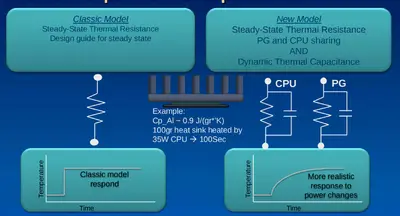Thermal Design Power (TDP) the maximum sustained power a processor can draw for a thermally significant period while running useful "real world" software under defined temperature and voltage limits (typically the thermal power an integrated circuit generates under TCASE,MAX). A TDP of an IC represents that upper point of the thermal profile and is used for determining the appropriate thermal solution design target.
Overview
As an integrated circuit operates, some of the power applied is dissipated in the form of heat. This heat must consequently be removed from the die and out of the system in order to maintain operational temperature range. The ability to remove heat depends on the power dissipation, ambient temperature, and the thermal resistance of the materials used in the construction of the package.
Where the total thermal resistance (ψJunction-Ambient, ψJA) is the thermal resistance of the Junction to Sink (ψJS which also includes ψTIM) and the thermal resistance of the Sink to Ambient (ψSA). Note that this is measured in °C/W. ψSA is a function of the heatsink material, its thermal conductivity, and its geometry.
Therefore the maximum allowable resistance can be calculated as
Thermal Capacitance
If an integrated circuit has been running at relatively cooler temperatures, the various materials such as the heatsink have also cooled. This mean that there is a small amount of time whereby it is possible for the IC to effectively exceed the rated amount of heat generated and have the heatsink quickly absorb this heat while still maintaining the rated TDP. Since Sandy Bridge, Intel has switch to a dynamic thermal capacitance model which allows their chip to take advantage of this short amount of time at run hotter and at higher frequency in order to extract additional performance.
Power Virus
- Main article: power virus
It is possible to craft synthetic code that toggles a large number of transistors on and off without doing any real work in order to generate a large amount of heat. This sort of code is almost never indicative of real-world code and could manage to exceed the rated TDP of chip. When this happens the processor's thermal control circuitry will kick in and throttle the chip in order to restore it to a safe operating range.
Configurable TDP
| This section is empty; you can help add the missing info by editing this page. |

